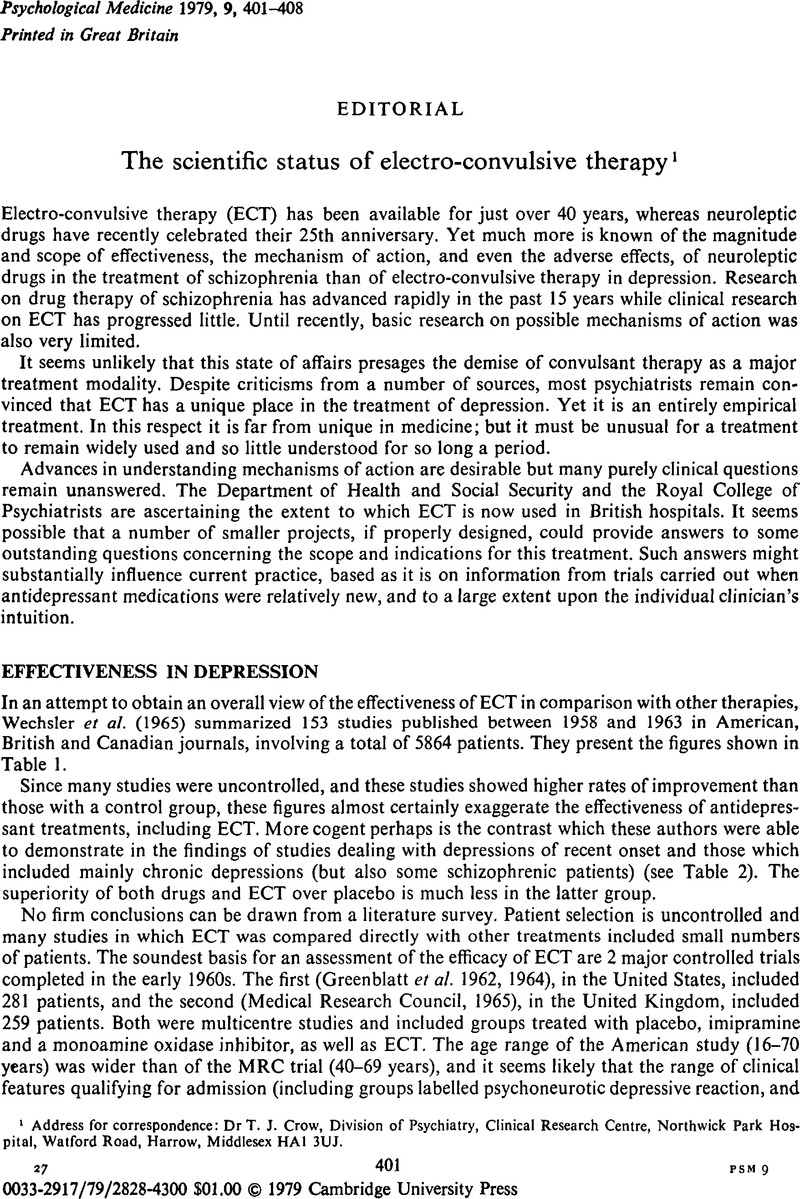Crossref Citations
This article has been cited by the following publications. This list is generated based on data provided by Crossref.
Fink, Max
1979.
EFFICACY OF ECT.
The Lancet,
Vol. 314,
Issue. 8155,
p.
1303.
Frey, J.J.
1979.
REALITIES OF PRIMARY CARE.
The Lancet,
Vol. 314,
Issue. 8155,
p.
1304.
MACFIE, CRAIGIE
1980.
PSYCHIATRY.
Medical Journal of Australia,
Vol. 1,
Issue. 9,
p.
405.
Slade, A. P.
and
Checkley, S. A.
1980.
A Neuroendocrine Study of the Mechanism of Action of ECT.
British Journal of Psychiatry,
Vol. 137,
Issue. 3,
p.
217.
Pinder, Roger M.
1980.
Vol. 15,
Issue. ,
p.
1.
Creed, Francis H.
1980.
Raising Standards in Psychiatry.
Bulletin of the Royal College of Psychiatrists,
Vol. 4,
Issue. 3,
p.
38.
Chou, ShelleyN.
Flanagan, R.J.
Prior, J.G.
Raper, S.M.
Widdop, B.
and
Volans, G.N.
1981.
BRAIN DEATH.
The Lancet,
Vol. 317,
Issue. 8214,
p.
282.
Callender, Kay
Jones, Gareth
and
Gordon, Douglas
1981.
THE NORTHWICK PARK ECT TRIAL.
The Lancet,
Vol. 317,
Issue. 8214,
p.
283.
Kendell, R. E.
1981.
The Present Status of Electroconvulsive Therapy.
British Journal of Psychiatry,
Vol. 139,
Issue. 4,
p.
265.
Van Zandijcke, M.
1981.
RECOVERY AFTER PROLONGED "FLAT" EEG.
The Lancet,
Vol. 317,
Issue. 8214,
p.
283.
Deakin, J F
1983.
Antidepressant effects of electroconvulsive therapy: current or seizure?.
BMJ,
Vol. 286,
Issue. 6371,
p.
1083.
Kiloh, L. G.
1983.
Non-Pharmacological Biological Treatments of Psychiatric Patients.
Australian & New Zealand Journal of Psychiatry,
Vol. 17,
Issue. 3,
p.
215.
Martin, B.A.
1986.
Electroconvulsive Therapy: Contemporary Standards of Practice.
The Canadian Journal of Psychiatry,
Vol. 31,
Issue. 8,
p.
759.
Martin, B.A.
and
Peter, A.M.
1987.
Civil Commitment and Consent for Electroconvulsive Therapy in Ontario.
The Canadian Journal of Psychiatry,
Vol. 32,
Issue. 1,
p.
35.
Lauter, H.
and
Sauer, H.
1989.
Katatone und dyskinetische Syndrome.
p.
165.
Lock, T.
and
McCulloch, J.
1991.
Local cerebral glucose utilization after chronic electroconvulsive shock: implications for the mode of action of electroconvulsive therapy.
Journal of Psychopharmacology,
Vol. 5,
Issue. 2,
p.
111.
Dunn, G.
Sham, P.
and
Hand, D.
1993.
Statistics and the nature of depression.
Psychological Medicine,
Vol. 23,
Issue. 4,
p.
871.
Fink, Max
2004.
Induced Seizures as Psychiatric Therapy.
The Journal of ECT,
Vol. 20,
Issue. 3,
p.
133.
Fink, Max
2006.
Challenges to British Practice of Electroconvulsive Therapy.
The Journal of ECT,
Vol. 22,
Issue. 1,
p.
30.
Regenold, William T.
Noorani, Robert J.
Piez, Deborah
and
Patel, Palak
2015.
Nonconvulsive Electrotherapy for Treatment Resistant Unipolar and Bipolar Major Depressive Disorder: A Proof-of-concept Trial.
Brain Stimulation,
Vol. 8,
Issue. 5,
p.
855.



